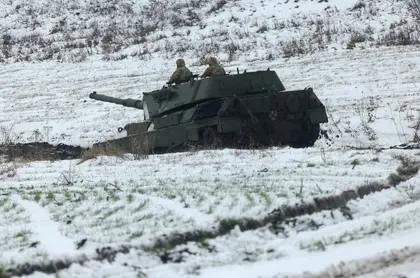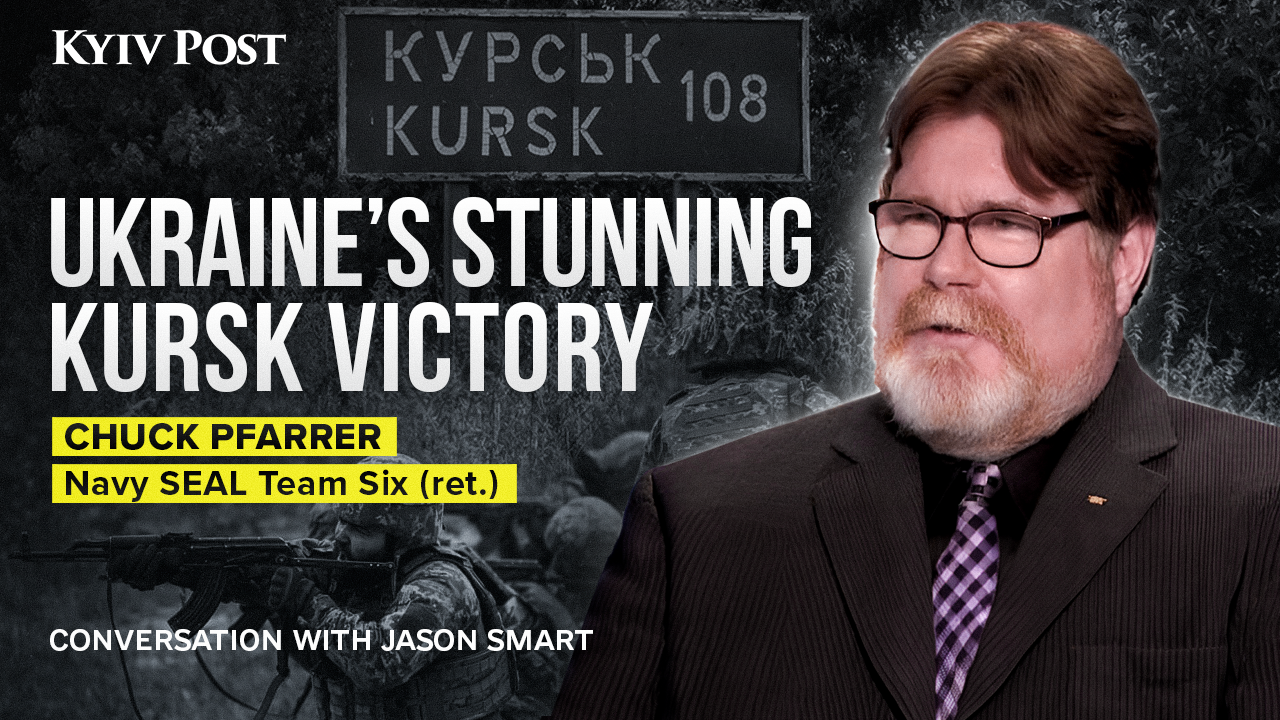The Cold War-era Leopard I main battle tank Leopard 1A5 was for the first time confirmed to be deployed near the fighting line in the Russo-Ukrainian war, and according to crew, the combat vehicle already has seen action, independent media reports said on Tuesday.
The French news wire service AFP published images of the, by modern standards, mostly obsolete Germany-manufactured fighting vehicle driving on a snowy farm field, and interviews with two crew members, at an undisclosed location close to fighting lines.
JOIN US ON TELEGRAM
Follow our coverage of the war on the @Kyivpost_official.
The mothballed vehicle, donated by the Danish military and refurbished by Germany according to the report, arrived in Ukraine in September. A crew member identified as Grigorii said the vehicle had already seen combat and “inflicted losses” on Russian forces.
Images showed the tank sporting a fresh paint job and with apparently a smoothly functioning gun elevation system, turret rotation motor and diesel engine.
The Leopard IA5 shown in the AFP video appeared to be a stock model with factory-standard 70mm frontal armor – in the Russo-Ukraine War sufficient to protect the tank crew from small arms and some light anti-tank weapons, but easily penetrated by rocket-propelled grenades, drone-toted explosives, guided missiles and automatic cannon saturating Ukrainian battlefields.
The Soviet-era T-64 and T-72 tanks most commonly operated by the Russian and Ukrainian armies in Ukraine are, depending on the specific type, rigged with between 600-1000mm of composite armor, sufficient to resist most weapons on the battlefield smaller than a tank cannon armor-piercing round, a heavy anti-tank missile or a medium-sized artillery shell.

Kyiv Brings Home 25 POWs, Including Wounded, in 1st Exchange of 2025
A crew member named Vitalii said the preferred tactic of the Armed Forces of Ukraine (AFU) with the Leopard I is to avoid close-in fighting and try and standoff at ranges of 3-4 kilometers (~2 to 5 miles) to take advantage of superior optics and fire control systems aboard the German vehicle.
The AFP report confirmed images appearing earlier in the week on social media of a Leopard I driving down a rural road, and of Ukrainian mechanics inside an abandoned building working on a Leopard I engine, according to reports in Ukraine’s eastern Kharkiv region. The Leopard 1A5 in that video, like in the AFP images, appeared to be factory stock without armor upgrades.
Ukrainian military information platforms in August reported the AFU’s 44th Mechanized Infantry Brigade, a newly raised formation drawing recruits mostly from the Chernihiv and Poltava regions, would be the first combat unit kitted out with the Leopard 1A5.
Like many Ukrainian fighting formations, the 44th operates a confusing mix of NATO nation-donated weaponry, including Soviet BMP-I infantry fighting vehicles from Poland and Valuk light armored cars from Slovenia. According to unconfirmed reports in Western media, the unit will later receive Polish Rosomak armored personnel carriers.
The 44th Brigade was raised in May and first saw combat in summer fighting in the southeastern Donbas sector, suffering both killed and wounded lost.
According to unit social media, the 44th currently has some soldiers conducting training and others deployed to east Ukraine. Unconfirmed reports place elements of the brigade in Ukraine’s Kharkiv region, near the city of Izium.
As of late November, according to German news reports, Germany had delivered 30 Leopard 1 tanks to Ukraine with 80 to follow by mid-2024. Denmark and the Netherlands are the donating nations, pulling the vehicles from mothballs or purchasing the long-obsolete tanks on the private market.
According to summer statements by German Defense Minister Boris Pistorius, Ukraine should eventually receive 195 Leopard 1A5 tanks refurbished by the Dusseldorf-headquartered arms conglomerate Rheinmetall and the original tank manufacturer Krauss-Maffei Wegmann (KMW). The first vehicle batch of ten tanks arrived in Ukraine in August.
The AFU, in September, citing mechanical defects, rejected 12 out of a second, 20-vehicle batch of Leopard 1A5 tanks, sourced from German privately held stocks.
At the time, Pistorius declined to comment on the refurbished tanks’ reliability or the quality of the German refurbishment.
Two of the vehicles had serious faults and the other ten had minor issues, and post-delivery repairs would fix all the problems, Danish Defense Minister Troels Lund Poulsen said in a Sept. 22 statement.
According to the Danish TV2 television channel, spare parts for the Leopard 1A5 are short across Europe, complicating present and future maintenance for the AFU’s already hard-pressed military mechanics.
In June, the AFU lost at least seven, and according to some accounts, as many as 17 much more modern and heavily armored German Leopard 2 tanks in failed assaults on the southern front.
Instead of engaging in tank-vs-tank long-range slugging matches as designed by German engineers, the AFU vehicles hit dense minefields, were ambushed by Spetsnaz teams operating anti-tank missiles and then were attacked by Russian helicopter gunships.
According to a Nov. 25 article in the authoritative Frankfurter Rundschau (FR) newspaper, Berlin also hopes to beef up Ukrainian tank stocks by buying back 25 Leopard 2 tanks from Switzerland.
Bern, since Russia’s invasion of Ukraine in Feb. 2022, has taken a hard line against arming Ukraine with Swiss weapons, or even Swiss ammunition, being sent by any current owner to Ukraine, on grounds that arming the AFU with Swiss weapons could compromise Swiss neutrality.
According to the FR article, Germany’s center-left coalition government hopes to bypass the Swiss rule of no re-export of Swiss weaponry to a third-party nation by returning the vehicles to the Bundeswehr’s tank park and then handing over 25 identical Leopard 2 tanks to Ukraine.
Swiss agreement with the idea is unconfirmed, and Germany’s own army is critically short of functioning tanks. It may not be in Germany’s national interest to send tanks it badly needs itself to Ukraine, the article said.
You can also highlight the text and press Ctrl + Enter










